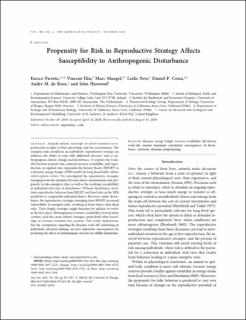| dc.contributor.author | Pirotta, Enrico | |
| dc.contributor.author | Hin, Vincent | |
| dc.contributor.author | Mangel, Marc | |
| dc.contributor.author | New, Leslie | |
| dc.contributor.author | Costa, Daniel P. | |
| dc.contributor.author | de Roos, André M. | |
| dc.contributor.author | Harwood, John | |
| dc.date.accessioned | 2021-05-07T12:34:40Z | |
| dc.date.available | 2021-05-07T12:34:40Z | |
| dc.date.created | 2020-09-24T14:50:13Z | |
| dc.date.issued | 2020 | |
| dc.Published | American Naturalist. 2020, 196 (4), 1-17. | |
| dc.identifier.issn | 0003-0147 | |
| dc.identifier.uri | https://hdl.handle.net/11250/2754184 | |
| dc.description.abstract | Animals initiate, interrupt, or invest resources in reproduction in light of their physiology and the environment. The energetic risks entailed in an individual’s reproductive strategy can influence the ability to cope with additional stressors, such as anthropogenic climate change and disturbance. To explore the trade-offs between internal state, external resource availability, and reproduction, we applied state-dependent life-history theory (SDLHT) to a dynamic energy budget (DEB) model for long-finned pilot whales (Globicephala melas). We investigated the reproductive strategies emerging from the interplay between fitness maximization and propensity to take energetic risks, as well as the resulting susceptibility of individual vital rates to disturbance. Without disturbance, facultative reproductive behavior from SDLHT and fixed rules in the DEB model led to comparable individual fitness. However, under disturbance, the reproductive strategies emerging from SDLHT increased vulnerability to energetic risks, resulting in lower fitness than fixed rules. These fragile strategies might therefore be unlikely to evolve in the first place. Heterogeneous resource availability favored more cautious (and thus more robust) strategies, particularly when knowledge of resource variation was accurate. Our results demonstrate that the assumptions regarding the dynamic trade-offs underlying an individual’s decision-making can have important consequences for predicting the effects of anthropogenic stressors on wildlife populations. | en_US |
| dc.language.iso | eng | en_US |
| dc.publisher | The University of Chicago Press | en_US |
| dc.title | Propensity for risk in reproductive strategy affects susceptibility to anthropogenic disturbance | en_US |
| dc.type | Journal article | en_US |
| dc.type | Peer reviewed | en_US |
| dc.description.version | publishedVersion | en_US |
| dc.rights.holder | Copyright 2020 The University of Chicago | en_US |
| cristin.ispublished | true | |
| cristin.fulltext | original | |
| cristin.qualitycode | 2 | |
| dc.identifier.doi | 10.1086/710150 | |
| dc.identifier.cristin | 1833116 | |
| dc.source.journal | American Naturalist | en_US |
| dc.source.40 | 196 | |
| dc.source.14 | 4 | |
| dc.source.pagenumber | E71–E87 | en_US |
| dc.identifier.citation | American Naturalist. 2020, 196(4), E71–E87 | en_US |
| dc.source.volume | 196 | en_US |
| dc.source.issue | 4 | en_US |
